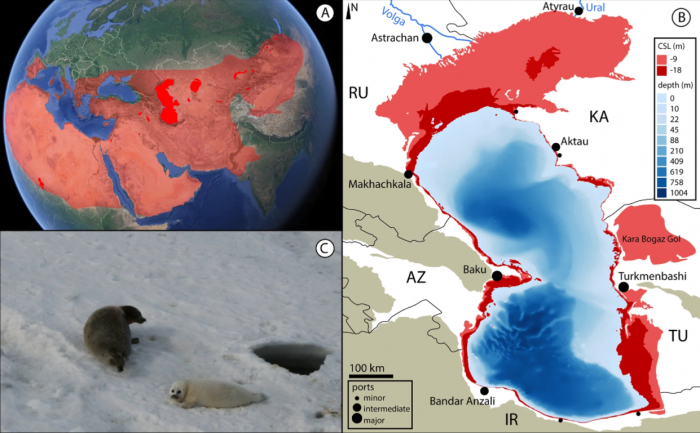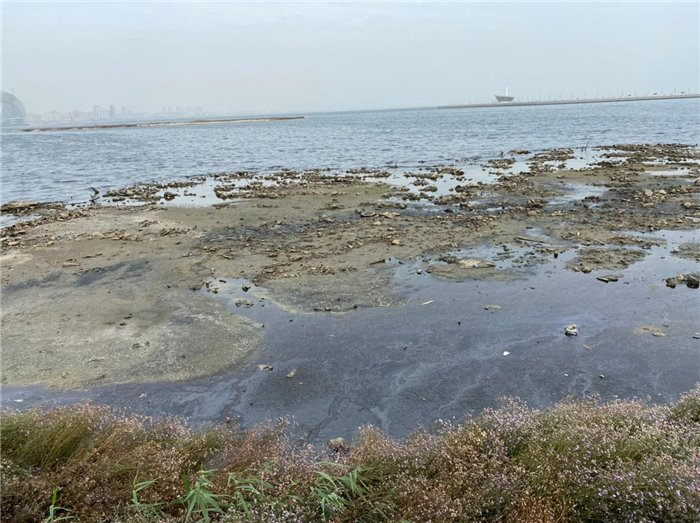The formation of modern civilization was conditioned by people’s settlement around the rivers and water basins for thousands of years. Therefore, the ecological condition of the water basin and solutions to its problems are some of the most pressing issues in all periods. In this regard, ecological problems caused by water level decrease in the Caspian Sea, one of the most unique water basins of the planet, and its negative impacts, which can affect the economy of the surrounding countries are topical issues.
Back to the Middle Ages, travelers of the middle ages have expressed their hesitations on the water level decrease of the Caspian Sea. Gathering the statistical data regarding this issue was launched starting from 1829-1937. Since then, the water level of the sea has risen and fallen three times. Estimates show that the lowest sea level in the last 500 years was reported in 1977.
As a result of the sea level drop by 1,5 m in the Caspian Sea since 2005, the sea drifted apart from its existing borders by 1 km and several hundreds of meters in some places. Some scientists, who consider these factors as seasonal, note that the process will continue until about 2050 and the sea level will fall by 2,5m.
Previous sea-level drop in the Caspian Sea occurred in 1977-1994. In 1977, the sea level was 1 m lower than the current level. However, the sea level rose again by 2,5 m, restoring the previous level in 1977-1995. The level of the sea began to fall gradually, starting from 2005. Scientists claimed that the drop will be more severe this time and the water level will fall by 5-6 years in nearly 75 years, resulting in the departure of the North Caspian. According to various scenarios stated in an article written by the German and Dutch scientists published in the journal “Nature Communications Earth & Environment”, the water level of the Caspian Sea will drop by 9-18 meters by the end of the century.

According to these speculations, the fluctuations regarding the water level in the Caspian Sea are related to its connection with the Aral sea through underground flows. According to a hypothesis, as a result of the flow of water in one direction or the other, the water level in the Caspian and Aral Seas increases or decreases inversely. However, geologists studying the nature of deep rocks in the region state that such speculations have no scientific basis.
Head of the department of “Economic and social geography” of the Baku State University, doctor of sciences in geography studies, professor Chingiz Ismayilov said that the fluctuations regarding the water level of the Caspian Sea are conditioned by three factors. He stressed that the difference in water level changes between 1,5 and 3 meters. Ismayilov said: “Three factors overlap in fluctuations in the water level of the Caspian Sea, and they are the ones that affect the rise and drop of the seawater level. These are the activity of the Sun, technogenic processes on Earth's surface, and the tectonic processes in the Caspian Sea, as well as the anthropogenic impact of humans, and the misappropriation of coastal areas.
In the professor’s view, to minimize the negative impact of these three factors, it is vital to apply and monitor the latest technology in effective use of the resources, especially the water resources. Although the accuracy of forecasts and calculations is of great importance, it will not be possible to avoid natural processes.
“Forecasts and calculations are assumptions, which can be false. We just need to know the general pattern and carry out our activities accordingly. By the results of 180 years of calculations, we have determined that sea-level equivalent is 3 meters,” Ismayilov said.

The Azerbaijani scientist also pointed to the negative impact of sewage discharged into the rivers flowing into the Caspian Sea. Here the biggest problem is the pollution of the Volga River, which provides 80% of the water flowing into the Caspian Sea.
The biggest problem in this context is the pollution of the Volga River, which provides about 80% of the water flowing into the Caspian Sea. The location of hundreds of industrial enterprises and eight Russian cities with a population of more than one million along the Volga River is one of the main causes of the problem. From this point of view, although the Kur River provides only 5-6% of the water pouring into the Caspian Sea, the sewage discharged by Armenian mining companies into the Okhchuchay River, the left tributary of the Araz River, in the last 2-3 decades has also had a negative impact.
Professor Ismayilov said that the threat is not only related to the pollution by mining companies.
“Armenia has been purposefully dumping molybdenum waste into the Okhchuchay River since the mid-1980s. There is also a danger of radioactive waste buried in the liberated Azerbaijani lands. The purposeful contamination negatively affects the ecological situation of the Araz River, which joins the Kur River and flows into the Caspian Sea,” he said.
All these problems seriously damage the unique bioresources of the Caspian Sea. Sturgeons, which are considered to be the most valuable fish species in the Caspian basin, are not the only ones of exceptional importance. The Caspian Sea is the only closed water basin inhabited by seals (known as the Caspian seal). There are 150 species of fish in the Caspian Sea. The most valuable resource in the Caspian Sea than sturgeon in terms of economic importance is kilka fish. Because fish flour made from kilka is used in poultry farms. One of the main reasons behind the common use of the middle part of the Caspian Sea is the issue of kilka resources.
Undoubtedly, fluctuations in the Caspian Sea’s water level harm the economies of other littoral countries. For example, as a result of a 2.5-meter rise in the sea level in 1977-1995, about 50,000 hectares of land in Azerbaijan were flooded, which inflicted a 2 billion-damage on the country’s economy. In total, the Caspian littoral countries lost $ 10 billion in just five years as a result of the flooding of coastal areas. At present, the declining water level in the Caspian Sea is hampering the work of the Caspian ports (Alat, Anzali, Aktau, Astrakhan, Turkmenbashi, etc.). In this situation, large tonnage ships designed for deeper waters will not be able to bypass the ports. In this regard, the joint efforts of the Caspian littoral states to address the existing problems are among today’s most important tasks. Only in this case, the companies that order the transportation of goods will not seek alternative routes.

- The solution to these problems will depend on the capacity of the Caspian littoral states to build their port economy in accordance with the current situation. If the port economy implements a flexible program in accordance with this situation, the buyer will not feel that there is a problem. If this is not achieved, of course, buyers will look for other ports. This situation will not only affect the work of ports but also tourism. Therefore, the beach areas will change and the beaches will be far from the sea, and recreation centres will have similar problems. Therefore, a flexible system must be established and all Caspian littoral states should be involved in this process, said the Azerbaijani scientist.
According to estimates, 80 million people could benefit from the optimal level of water in the Caspian Sea. In this regard, the Caspian Sea is more significant than the Aral Sea and the Dead Sea, where the water levels have dropped significantly. Hence, the decline in water levels in the Caspian Sea will adversely impact the economies of coastal countries, as well as Iraq, Turkey and Syria. The reason is that winter winds bring the moisture of the Caspian Sea to the basins of rivers flowing from these countries. The vast drop in water levels in the Caspian Sea will reduce the amount of evaporation, which will lead to a shortage of drinking water in the Middle East.

It is stressed that Russia can play the most significant role in preventing the decline of the water levels in the Caspian Sea. In this regard, the Don River, which flows near the Volga River and the Caspian Sea and fills the Tsimlyan Reservoir in the Volgograd region of Russia, can be used. However, this is unlikely to happen in the face of global warming. Another larger-scale alternative is the construction of a 700-kilometre underground or surface water pipeline connecting the Azov and Caspian seas. Through this pipeline, water can flow from the open water basin of the Azov Sea to the closed water basin of the Caspian Sea. In this case, the Caspian Sea will have access to the world ocean.
However, prior to the implementation of projects that require a large sum of money, the Caspian littoral states should increase their joint efforts to address the environmental issues of this unique closed word basin. Scientists believe that the monitoring and steps taken by the Caspian littoral states to eliminate this problem do not bring the desired impact.
- A document on the ecology of the Caspian sea was signed prior to the signing of the document on its status. All states have signed that document and everyone agreed that there are environmental problems. However, a special group must be set up to conduct regular monitoring. Instead, each state says in its report that "everything is fine, there is only a small problem." In fact, the situation is very disappointing. Professor Chingiz Ismayilov suggested that a group, which represents all the Caspian littoral states, should be established and should be authorized to monitor the coast of any Caspian country once a month.
Professor Chingiz Ismayilov said he was optimistic about the solution of the problems of the Caspian Sea and was hopeful about the future. He added that we all have a responsibility to protect this pearl.
Sahil Iskandarov, politician
More about: #CaspianSea















































